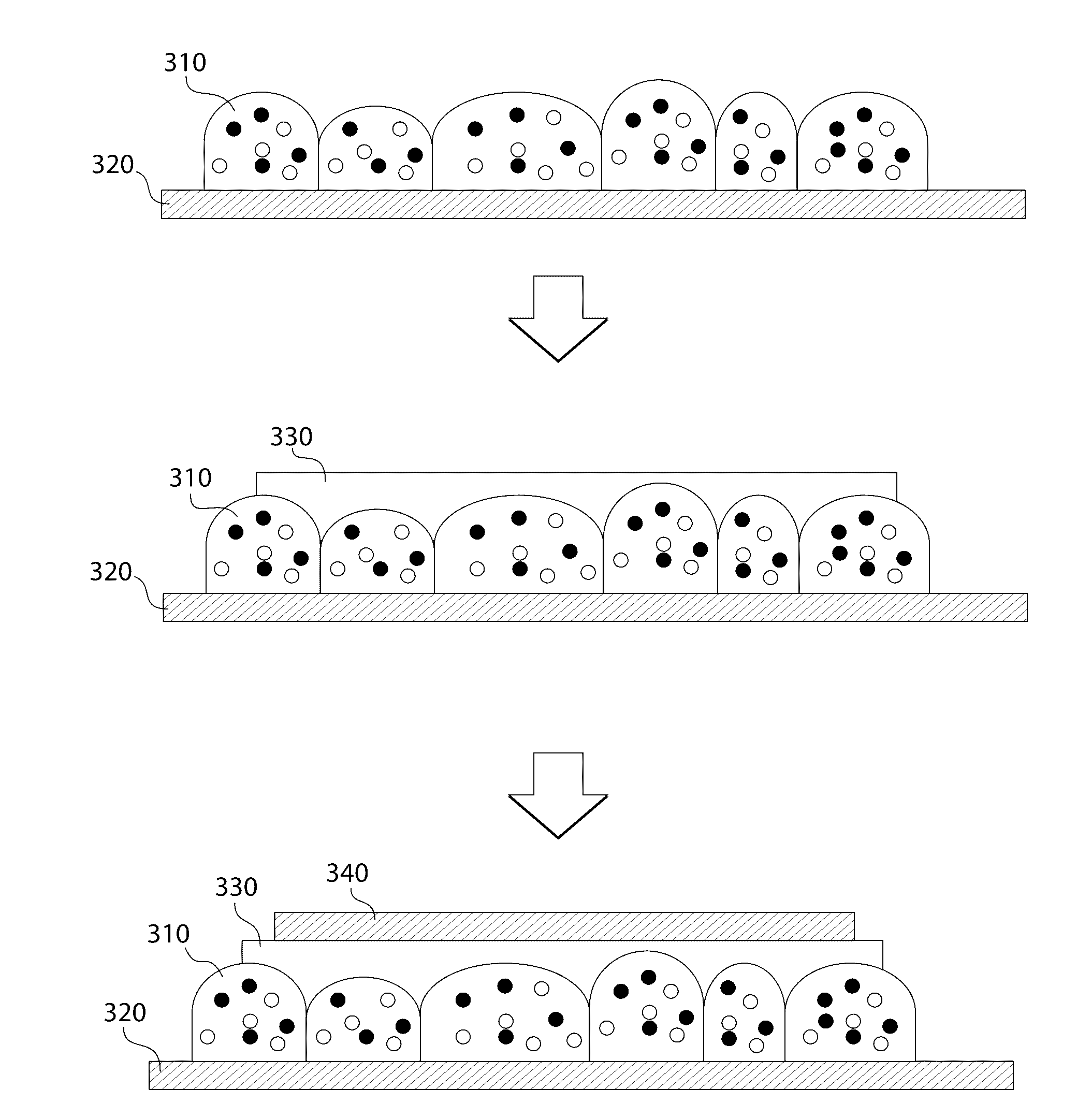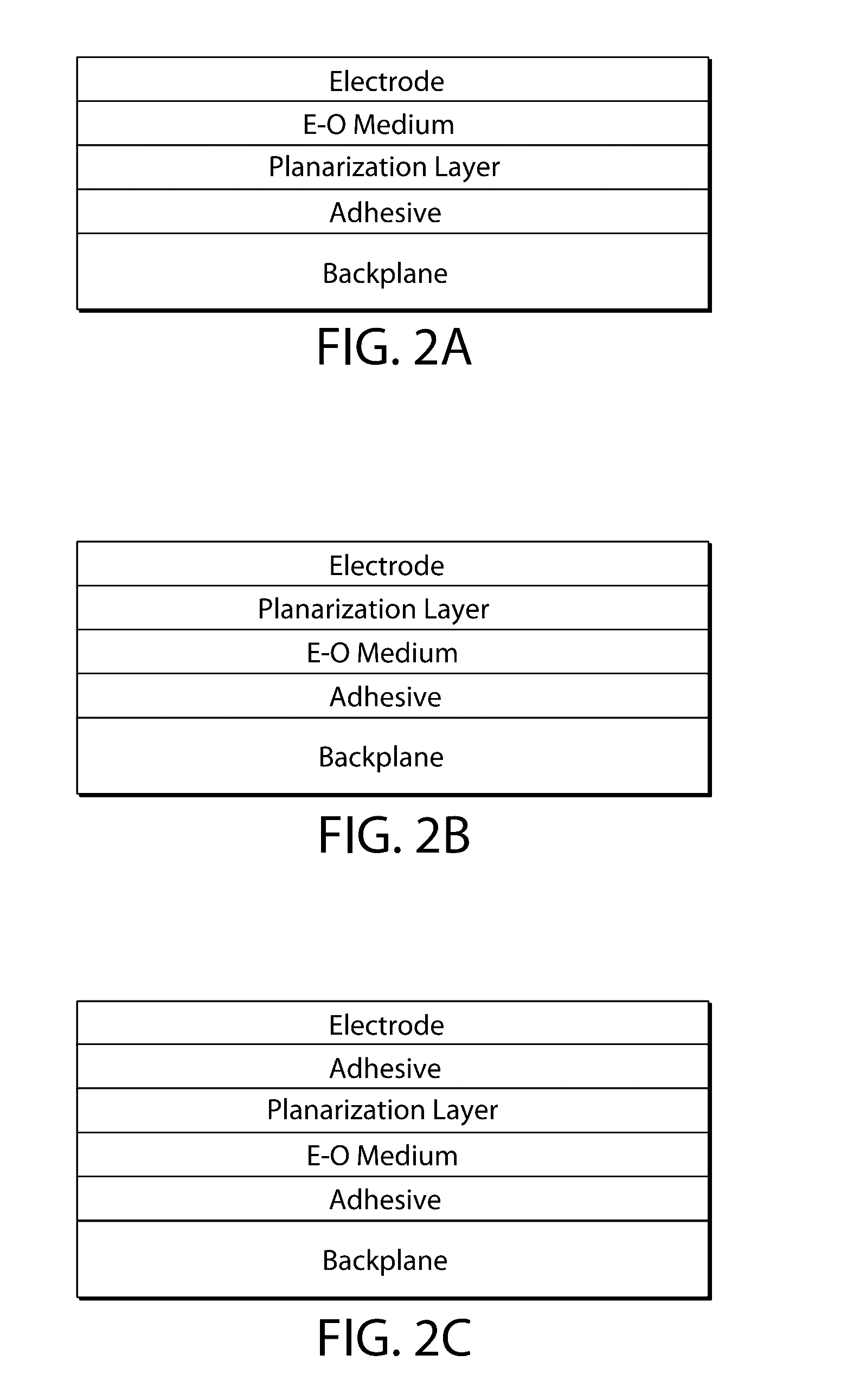Polymer formulations for use with electro-optic media
a technology of electro-optic media and polymer formulations, applied in the direction of instruments, material analysis using wave/particle radiation, adhesive types, etc., can solve the problems of presenting certain problems, substantial voltage drop within the adhesive layer, and adhesive adhesive for use in electro-optic displays
- Summary
- Abstract
- Description
- Claims
- Application Information
AI Technical Summary
Benefits of technology
Problems solved by technology
Method used
Image
Examples
example 1
Evaluation of Surface Planarity
[0102]A UV curable planarization layer including (meth)acrylated polyurethane oligomer resins was prepared for deposition on an encapsulated electrophoretic medium. The formulation was prepared by mixing 45 parts-per-hundred-resin(phr) (meth)acrylated resin (SR9088) and 15 phr polyester urethane diacrylate oligomer (CN964) and 40 phr acrylate oligomer (CN3108) in a bottle, heating the mixture to 60° C. for 2 hours, then rolling overnight, to produce a high-viscosity polymer mixture. After thorough mixing, 1 phr of 1-hydroxycyclohexyl-phenyl-ketone (CPK) photoinitiator and 1 phr of diphenyl(2,4,6-trimethylbenzoyl)phosphine oxide (TPO) photoinitiator were added, and the mixture was heated to 40° C. for 2 hours, and the formulation was rolled overnight, again, to homogenize the mixture.
[0103]The UV curing formulation described above was spread over an electro-optic medium on a release sheet using bar-coating, with the bar set for a 1 mil (25 μm) gap thick...
example 2
Evaluating Formulation Performance
[0106]In addition to providing improved planarity between the top electrode and the backplane, the formulations also improved the stability of a four-layer structure (electrode / electro-optic medium / planarization formulation / electrode) including the formulation. Structures including the formulation did not delaminate under strains that caused a similar four-layer structure (release / electro-optic medium / conventional adhesive / electrode) to delaminate.
[0107]Four-layer structures, containing planarization formulations in the place of conventional adhesive, also demonstrated improved performance, as measured by switching speed and dynamic range. This is likely due to conventional adhesives being roughly insulating when applied at thicknesses of 5-30 μm. Addition of a UV planarization layer to a layer of encapsulated bistable (black / white) electrophoretic medium coated directly on ITO showed a speed boost to both the white and the dark states with a 250 ms...
example 3
UV Polymer Formulations for VT Glass
[0110]Several UV-activated polymer formulations were prepared for use as adhesives and for planarizing a polymer-dispersed electrophoretic (PDEPID) layer or an encapsulated electrophoretic particle layer to be incorporated into VT glass. The formulations will be used to bond an ITO (PET / ITO front electrode) to the polyvinyl alcohol binder of a PDEPID skim coat, as depicted in FIG. 10B. While only variable transmission devices are exemplified below, a variable reflectivity device can be constructed using the same techniques, but using a reflective substrate in lieu of the transparent medium. Such a construction is shown in FIGS. 11A and 11B. Of course, switching variable transmission films that can be applied to existing substrates, e.g., windows, mirrors, signs, walls, metal, etc. In one embodiment of a variable reflectivity device, the reflective substrate is a mirror, e.g., silvered glass. In another embodiment, the reflective substrate is a mat...
PUM
| Property | Measurement | Unit |
|---|---|---|
| Temperature | aaaaa | aaaaa |
| Fraction | aaaaa | aaaaa |
| Fraction | aaaaa | aaaaa |
Abstract
Description
Claims
Application Information
 Login to View More
Login to View More - R&D
- Intellectual Property
- Life Sciences
- Materials
- Tech Scout
- Unparalleled Data Quality
- Higher Quality Content
- 60% Fewer Hallucinations
Browse by: Latest US Patents, China's latest patents, Technical Efficacy Thesaurus, Application Domain, Technology Topic, Popular Technical Reports.
© 2025 PatSnap. All rights reserved.Legal|Privacy policy|Modern Slavery Act Transparency Statement|Sitemap|About US| Contact US: help@patsnap.com



